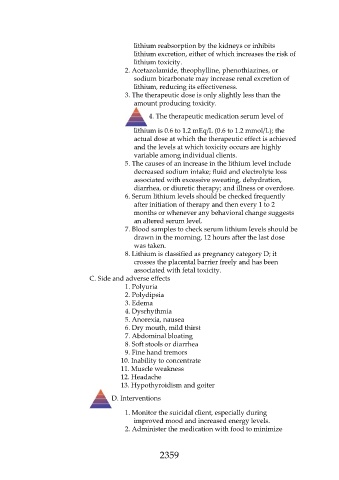Page 2359 - Saunders Comprehensive Review For NCLEX-RN
P. 2359
lithium reabsorption by the kidneys or inhibits
lithium excretion, either of which increases the risk of
lithium toxicity.
2. Acetazolamide, theophylline, phenothiazines, or
sodium bicarbonate may increase renal excretion of
lithium, reducing its effectiveness.
3. The therapeutic dose is only slightly less than the
amount producing toxicity.
4. The therapeutic medication serum level of
lithium is 0.6 to 1.2 mEq/L (0.6 to 1.2 mmol/L); the
actual dose at which the therapeutic effect is achieved
and the levels at which toxicity occurs are highly
variable among individual clients.
5. The causes of an increase in the lithium level include
decreased sodium intake; fluid and electrolyte loss
associated with excessive sweating, dehydration,
diarrhea, or diuretic therapy; and illness or overdose.
6. Serum lithium levels should be checked frequently
after initiation of therapy and then every 1 to 2
months or whenever any behavioral change suggests
an altered serum level.
7. Blood samples to check serum lithium levels should be
drawn in the morning, 12 hours after the last dose
was taken.
8. Lithium is classified as pregnancy category D; it
crosses the placental barrier freely and has been
associated with fetal toxicity.
C. Side and adverse effects
1. Polyuria
2. Polydipsia
3. Edema
4. Dysrhythmia
5. Anorexia, nausea
6. Dry mouth, mild thirst
7. Abdominal bloating
8. Soft stools or diarrhea
9. Fine hand tremors
10. Inability to concentrate
11. Muscle weakness
12. Headache
13. Hypothyroidism and goiter
D. Interventions
1. Monitor the suicidal client, especially during
improved mood and increased energy levels.
2. Administer the medication with food to minimize
2359

